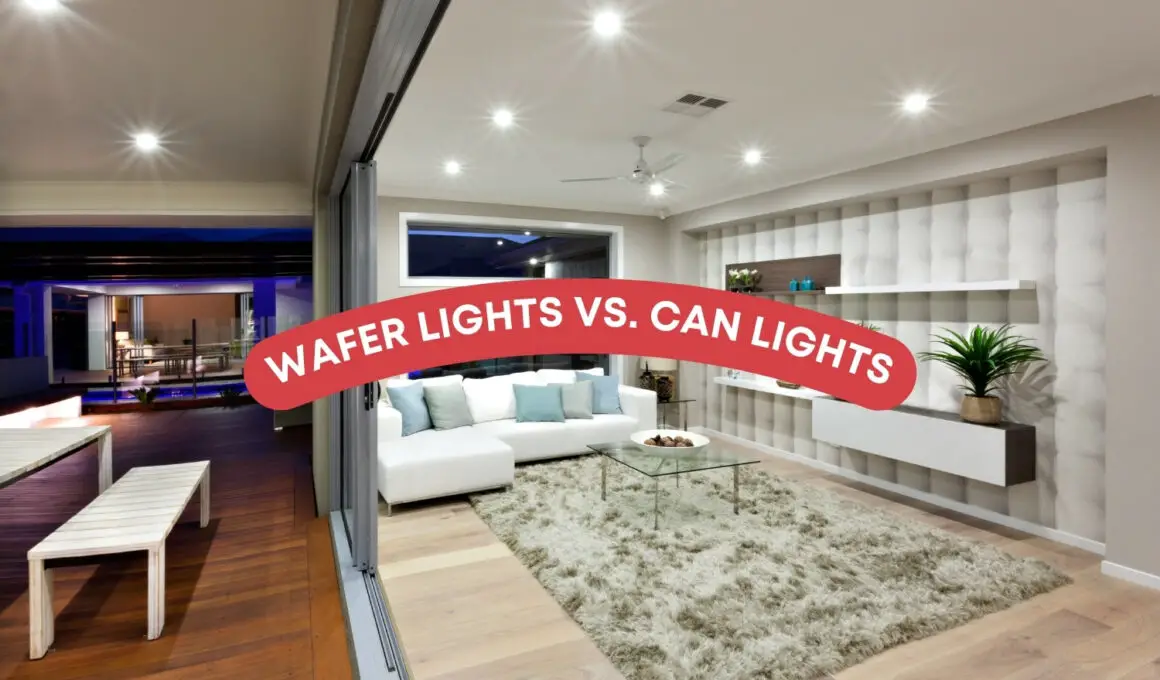Table of Contents Show
Lighting is more than just a functional component of a home—it’s an integral part of the design that influences the overall aesthetics and ambiance.
With over 13 years of experience in the interior decorating field, I’ve come to appreciate the critical role lighting plays in creating a warm, inviting space. Two popular options in the lighting arena are Wafer Lights and Can Lights, each boasting its own unique set of advantages.
As an interior decorator, one of the key decisions I often help homeowners make is choosing the right lighting. After all, the correct lighting can enhance your space’s look and feel, while improper lighting can dampen even the most beautifully decorated room.
This blog post’ll dive deep into Wafer Lights and Can Lights.
Can Lights Vs. Wafer Lights
The main difference between Can Lights and Wafer Lights lies in design, installation, and energy efficiency. Can Lights, known for their versatility and directed lighting, require more ceiling space and a complex installation. Conversely, Wafer Lights, recognized for their slim profile, fit in tighter spaces, are easier to install and are generally more energy-efficient. While both options provide efficient illumination, the choice depends on your specific space, lighting needs, and aesthetic preferences.
Can Lights | Wafer Lights | |
|---|---|---|
| Design | Traditional, larger size | Modern, ultra-thin profile |
| Installation | Fits in tighter spaces with no need for housing; easier installation | Generally more energy-efficient due to the predominant use of LEDs |
| Energy Efficiency | Varies; LED models are energy-efficient | Generally more energy-efficient due to predominant use of LEDs |
| Adjustability | Can direct light; more suitable for task/accent lighting | Light is more diffused; less suitable for task/accent lighting |
| Cost | Lower initial cost; potentially higher installation and energy costs | Higher initial cost; potentially lower installation and energy costs over time |
| Aesthetics | Wide variety due to longer presence in the market | Sleek design; less variety compared to Can Lights |
We’ll dissect their pros and cons, compare them side by side, and provide insights to help you make an informed decision. Throughout my career, I’ve not only decorated spaces but also shared my knowledge through these posts to assist readers like you in making informed decisions about your home’s design aspects.
What are Can Lights?

Can Lights, also known as recessed lights or downlights, are fixtures designed to be installed into hollow openings in a ceiling. Having had first-hand experience installing and recommending these lights in various homes over my 13 years as an interior decorator, I can attest to their discreet charm. They offer a clean, streamlined look and are ideal for a minimalist or modern aesthetic.
Can Lights consist of three main components: the housing, the trim, and the bulb. The housing is the larger, outer component that sits tucked away within the ceiling, making it unseen. The trim is the visible part of the light that you can see when looking up at the ceiling, and the bulb sits within the trim, shining light downwards.
These lights are incredibly versatile and can serve various purposes, such as general room, task, or accent lighting. They can be used in nearly every room in a home, including kitchens, living rooms, bedrooms, and bathrooms.
Over the years, Can Lights have evolved significantly, with variations in sizes, styles, and types, like standard, shallow, IC-rated (Insulation Contact), and non-IC-rated? This variety allows homeowners to select an option that fits their needs and complements the existing decor.
With all these attributes, Can Lights have become a go-to choice for many homeowners and interior decorators like myself? But before we make a call on whether they’re the better choice, let’s understand their counterpart – Wafer Lights.
What are Wafer Lights?

Wafer Lights, also known as ultra-thin or slim recessed lights, have revolutionized home lighting with their sleek design and easy installation process. As the name suggests, these lights are incredibly thin, boasting a low-profile design that allows them to be installed in areas with limited ceiling space.
Similar to Can Lights, Wafer Lights are also recessed into the ceiling, but they do not require recessed housing for installation. This feature gives them the advantage of fitting into tighter spaces and the flexibility of being installed virtually anywhere, even directly under joists or ductwork.
The light provided by Wafer Lights is typically diffused, giving off a gentle and uniform illumination that’s easy on the eyes. This type of lighting is perfect for creating a cozy, welcoming ambiance in a room.
Available in different sizes and color temperatures, Wafer Lights can be tailored to suit a variety of settings and decor styles. You can find them in diameters as small as 3 inches, up to 6 inches, or more, making them versatile for different lighting needs.
The color temperature range allows homeowners to choose between a warm, cozy light to a bright, cool light based on their preference.
While their aesthetics and versatility make them a worthy competitor to Can Lights, it’s essential to note that each has its own set of pros and cons, which we’ll dive into later. But for now, it’s safe to say that Wafer Lights have carved out a niche for themselves in the realm of home lighting.
Comparison Between Can Lights and Wafer Lights
Both Can Lights and Wafer Lights have their unique sets of features and characteristics. Understanding these differences is crucial in making an informed decision about the best lighting option for your space.
1. Size and Space Considerations
Can Lights require a significant amount of ceiling space due to their housing component? This can be a limitation in homes with lower ceilings or tight spaces. On the other hand, Wafer Lights, with their ultra-thin profile, can fit into almost any space, making them ideal for ceilings with limited space.
2. Energy Efficiency
In terms of energy efficiency, Wafer Lights usually come out on top. They’re generally available in LED versions, known for their energy-saving capabilities. While Can Lights also offer LED options, the older models that use incandescent or halogen bulbs may not be as energy efficient.
3. Installation Process
The installation process for Can Light can be quite labor-intensive as they require specific recessed housing. Wafer Lights, with their slim profile and no need for a housing unit, are easier and quicker to install, often resulting in lower labor costs.
4. Cost Comparison
The initial cost of Can Lights can be lower than that of Wafer Lights. However, when you factor in the installation costs and long-term energy usage, Wafer Lights might be the more cost-effective option in the long run.
5. Variety and Design Aesthetics
Both Can Lights and Wafer Lights come in a range of sizes and styles to suit various interiors. However, Can Lights might offer a more extensive selection due to its long presence in the market.
6. Safety Considerations
With Can Lights, you need to consider insulation contact (IC-rated or non-IC-rated), depending on whether they come into contact with insulation. Wafer Lights generate less heat due to their LED nature and generally don’t require special considerations for insulation contact.
Understanding these differences can help you decide the most suitable lighting for your needs. As we delve into the pros and cons of each in the next sections, you’ll gain an even deeper understanding of what each type of light has to offer.
Pros and Cons of Can Lights
Like any other fixture, Can Lights have its strengths and weaknesses. Being aware of these can help in determining if they’re the right fit for your space.
Pros of Can Lights
- Versatile Design: Can Lights come in a variety of sizes and designs, offering options to suit different decor styles. They can also be adjustable, allowing you to direct the light where needed.
- Discreet Appearance: When installed, Can Lights are flush with the ceiling, providing a clean, streamlined look. They are unobtrusive and blend seamlessly into the ceiling, which can be particularly beneficial in rooms where you wish to draw attention to other design elements.
- Multifunctional: Can Lights can serve as general, task, or accent lighting, making them an adaptable option for various lighting needs.
Cons of Can Lights:
- Requires Significant Ceiling Space: Due to the housing component, Can Lights require a significant amount of ceiling space for installation. This could be a limitation in homes with lower ceilings or limited ceiling cavity space.
- Installation Complexity: The installation process can be more labor-intensive and time-consuming compared to some other lighting options. Professional installation is generally recommended, which could add to the overall cost.
- Potential for Energy Loss: If not correctly installed or if non-IC rated lights are used in contact with insulation, Can Lights can lead to energy loss through heat leakage into the attic. However, this can be mitigated by using IC-rated lights where necessary and ensuring proper installation.
Knowing these pros and cons is an essential step in determining whether Can Lights are the right choice for your space.
Pros and Cons of Wafer Lights
Wafer Lights have rapidly gained popularity for their sleek design and easy installation. However, they too come with their own set of advantages and drawbacks. Let’s delve into them.
Pros of Wafer Lights:
- Space-efficient Design: One of the major advantages of Wafer Lights is their ultra-thin profile. They do not require a housing component, allowing them to be installed in tight spaces where traditional recessed lights may not fit.
- Easy Installation: Since they don’t require a housing component, Wafer Lights are generally easier and quicker to install than Can Lights, potentially lowering labor costs.
- Energy-efficient: Most Wafer Lights use LED technology, known for their energy-saving capabilities. This can result in lower electricity bills in the long run.
Cons of Wafer Lights:
- Higher Initial Cost: Wafer Lights tend to be more expensive upfront than traditional Can Lights. However, the difference may be offset by lower installation costs and energy savings over time.
- Limited Adjustability: Unlike some Can Lights, Wafer Lights typically can’t be adjusted to direct light in specific directions. They usually provide a more diffused light, which may not be suitable for task or accent lighting.
- Durability Concerns: Some users have raised concerns about the durability and lifespan of Wafer Lights compared to traditional Can Lights. However, this can vary widely depending on the specific product and brand.
Understanding the pros and cons of both Can Lights and Wafer Lights can help you make a more informed decision on which option suits your needs and preferences best.
Expert Opinions and Reviews
Choosing the right lighting for your home is a significant decision, and often, hearing from experts and users can provide valuable insight. With my expertise as an interior decorator spanning over 13 years, combined with insights from fellow professionals and user reviews, here’s the verdict on Can Lights and Wafer Lights.
1. Can Lights
Can Lights have been a staple in interior lighting for many years. Many experts appreciate their ability to offer directed lighting, making them an excellent choice for highlighting architectural features or artwork.
They are also known for their wide range of styles and sizes, which allows them to blend with various decor styles. However, some professionals and homeowners mention the higher installation cost and the potential for energy loss if not correctly installed.
2. Wafer Lights
Wafer Lights have been lauded for their sleek design and easy installation process. Experts in the field often recommend them for homes with limited ceiling space, and their energy efficiency is a well-praised feature.
Users appreciate the diffused light that they provide, which can create a soft, comfortable ambiance. However, some users point out the higher upfront cost and the lack of adjustability in lighting direction as potential drawbacks.
Both Can Lights and Wafer Lights have their fans among professionals and homeowners alike. The choice between the two often boils down to the specific needs of your space, your aesthetic preferences, and your budget.
Frequently Asked Questions
Are Can Lights and Wafer Lights energy-efficient?
Both Can Lights and Wafer Lights offer energy-efficient models, especially those using LED technology. However, Wafer Lights are generally more energy-efficient as they are predominantly available in LED versions.
Do I need a lot of ceiling space for Can Lights and Wafer Lights?
Can Lights require a significant amount of ceiling space due to their housing component. Conversely, Wafer Lights, due to their ultra-thin profile, can fit in tighter spaces and do not require recessed housing.
Which one is more cost-effective, Can Lights or Wafer Lights?
While Wafer Lights may have a higher upfront cost, they can be more cost-effective in the long run due to lower installation costs and long-term energy savings. Can Lights might be cheaper initially but can incur higher installation costs and potentially higher energy costs, especially if older, non-LED models are used.
Can I use these lights in a bathroom?
Both Can Lights and Wafer Lights can be used in bathrooms. However, ensure that they are rated for wet or damp locations to avoid any safety issues.
Do Wafer Lights provide enough lighting for a room?
Yes, Wafer Lights can provide ample illumination for a room. However, the amount of light you need will depend on the room size, the color of your walls and ceiling, and how the room is being used. It’s recommended to consult with a lighting expert to determine the right number and placement of lights for your space.
Can I install these lights myself?
While it’s possible to install both types of lights by yourself, it’s generally recommended to hire a professional, particularly for Can Lights due to their more complex installation process.
Wrapping it up
Choosing between Can Lights and Wafer Lights comes down to personal preference, the specifics of your space, and your lighting needs. Can Lights offer versatility, a range of designs, and the ability to direct light, but they require more ceiling space and a more complex installation process.
On the other hand, Wafer Lights, with their slim profile, are great for tight spaces, easier to install, and typically more energy-efficient, but they might come with a higher initial cost and offer less adjustability in light direction.
Remember, lighting is a crucial aspect of any room, affecting not just the look but also the feel of the space. Therefore, it’s always worth spending some time understanding your options and making an informed choice.
Whichever option you choose, both Can Lights and Wafer Lights have the potential to beautifully illuminate your space and enhance your home’s aesthetic appeal.









